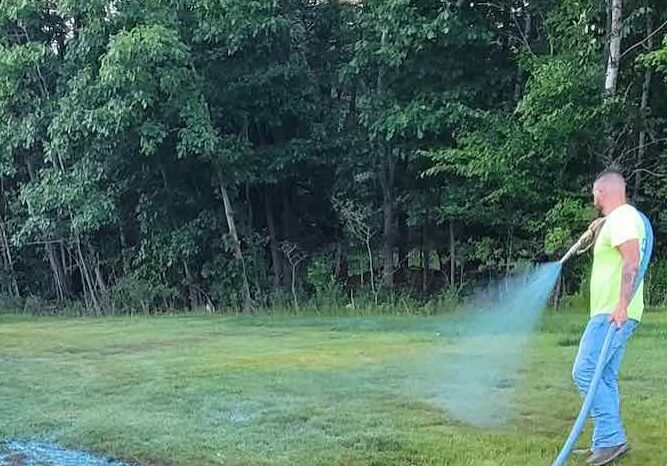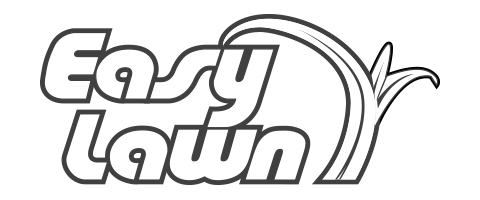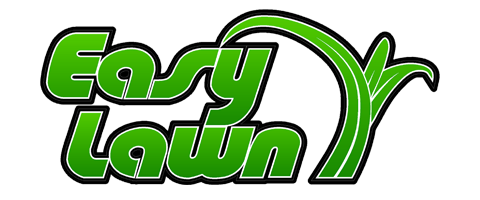Can You Hydroseed Over an Existing Lawn?

Share this article!
There are many methods to address patchiness or brown spots in your lawn, and depending on the extent of the lawn damage or amount of bare spots involved, using hydroseed over your existing lawn can help fill in those spots to grow a great looking lawn.
Before you make any decisions about how to improve your lawn, it’s a good idea to understand how hydroseeding works, how it can be used on existing lawns, and the role it can play in improving the overall look and feel of your yard.
Pros of Hydroseeding over an Existing Lawn
Hydroseeding over existing lawn has a few advantages that landscapers and homeowners can expect to enjoy:
Primarily, hydroseeding is a quick way to cover up lawn inconsistencies. Within a few weeks, you can have a more even lawn, as hydroseed is one of the fastest germinating methods to grow new grass.
Hydroseeding over an existing lawn is also generally very cost effective, as it can help even out a lawn without the need for starting from scratch to get a lush, even lawn.
Cons of Hydroseeding over an Existing Lawn
It’s not uncommon for homeowners and landscapers to be confused about if, or how, hydroseeding an existing lawn should be approached. One of the reasons for this confusion is that if it’s done incorrectly, hydroseeding over existing lawn can negatively impact the established grass, causing it to brown or even die off entirely.
The biggest downside of hydroseeding over existing lawn is going forward with the process without an experienced professional, which can lead to less-than-desirable results.
What is Overseeding with Hydroseed?
Overseeding is the process of applying seeds to an established lawn to help fill in bare spots and unevenness. This can be done by hand, via a power rake, or by hydroseeding.
Overseeding with hydroseeding is one of the quickest ways to overseed, and can be very effective at targeting problem areas in lawns. It’s important to note that for best results, the hydroseeding mixture should be modified to account for the process — for example, a standard hydroseed mixture will generally be too thick for overseeding purposes.
Advice from the pros:
If the hydroseed mixture is too thick, it can potentially suffocate the existing grass creating problems and additional bare spots. Make sure the hydroseed slurry has been mixed especially for overseeding, so the application doesn’t damage grass that is doing well.
Benefits of Hydroseeding as an Overseeding Process
Using hydroseed to overseed can provide a variety of advantages like even distribution and cost effectiveness. It’s a quick way to help fill in unhealthy gaps in lawns. This process can also help provide an added boost to an established lawn, so the whole area looks revived and refreshed.
Disadvantages of Hydroseeding as an Overseeding Process
Unfortunately, it’s easy to incorrectly overseed with hydroseeding, which can result in additional dead grass or added patchiness. If the seed mixture is different from the variety of grass that’s established in the area, there’s a chance that the overseeded area may vary in appearance slightly from the existing grass.
Advice from the pros:
Match the seed type(s) to the established grass to help avoid aesthetic variations in grass color and appearance.
It’s also important to consider where you’ll need the overseeding done, and whether or not hydroseeding equipment can realistically reach it. Most hydroseeding rigs are rugged and some can even spray up to 180’, but there still may be areas where it’s not convenient or cost effective to bring in a hydroseeder, such as very small areas.
Should you Hydroseed Over Your Existing Dead or Patchy Lawn, or Start from Scratch?
For the best answer to this question, consider the following factors:
Firstly, the state of your established lawn needs to be evaluated, as well as the state of the soil under the grass. Secondly, your budget can also help determine the best answer, as starting from scratch with sod can be costly. Starting over by hand seeding, by comparison, will likely be more affordable but will take more time than hydroseeding or sod to see results.
If you’re working with a limited budget and need quick results, hydroseeding over an existing lawn that doesn’t have too much patchiness is a cost effective choice.
Conversely, if your lawn has more patches than not, or you’ve got a lot of dead grass or places where it’s struggling, starting from scratch may yield better results, since there may be an underlying reason that grass isn’t doing well.
Hydroseeding Ground Preparation for Existing Lawns
Ground preparation for hydroseeding existing lawns is an important step to ensuring you get the best possible results from your project. The right foundation in both the existing lawn, and the bare spots or patches that need to be filled, will help seeds establish well and look their best.
Clear Debris
The entire project area should be clear of rocks, sticks, leaves, and any other type of debris, as hydroseed slurry has the best chance of success when applied to bare ground. A good approach is to walk the area removing large bits of debris, and then follow after with a rake to remove smaller debris.
Remove Invasive Species
Seed will have a difficult time establishing if it’s competing for nutrients and real estate with other plant life. To make sure grass can establish without this kind of competition, assess the area and remove any climbing, creeping, or spreading plants or weeds by hand.
If an herbicide or weed killing product is necessary to clear the area, plan this process several weeks in advance of hydroseeding, so you don’t have any residual herbicide chemicals in the environment to interfere with seed germination.
Aerate and Dethatch the Ground
Hard, compact ground makes it difficult for grass seeds to take root and grow. The young roots will have trouble attaching to the ground, and may become shallow and the new grass may even brown or die as it tries to establish. To provide a more hospitable environment, aerate and dethatch the areas of lawn that need the most additional growth.
Aerating the entire lawn can also be a great step to help your existing grass grow more lush and green. This process also increases the effectiveness of fertilizers and watering, enhancing results.
How to Hydroseed Over an Existing Lawn
Hydroseeding over an existing or patchy lawn is possible with the right ground preparation, slurry thickness, and application. By taking a few steps before the actual hydroseeding, you can improve the chances of success and set your project up for a great-looking result.
Reduce Mulch Thickness
Hydroseed slurry or mulch is thick and dense intentionally — designed this way to keep seeds and fertilizer in place in the face of natural forces like rain, wind, and erosion. When using hydroseeding as an overseeding method however, not accounting for the slurry thickness is one of the biggest mistakes you can make.
Because spray is applied over existing grass, if the slurry is too thick, it can suffocate the established grass, creating new dead or brown patches. Generally, reducing the mixture thickness by about ⅓ will allow grass to grow through it, while also benefiting from the fertilizers in the slurry.
Target Patchy or Dead Grass Areas
When applying hydroseed as an overseeding method, plan to target spray the areas most in need of help. While it’s possible and okay to spray existing grass, it’s still wise to minimize as much of the overlap as possible.
Conclusion
Using hydroseed to overseed can be a quick and efficient way to rejuvenate existing grass and help the whole lawn look more lush and green. Especially in the hands of a professional, who can evaluate the project ahead of time, make proper recommendations for the type of seeds, the thickness of the slurry mixture, and the application, the results can be very successful. Learn more about hydroseeding applications in our resource center, or calculate how much you can expect to pay to overseed your yard or lawn space with our Hydroseeding Mulch Calculator.

